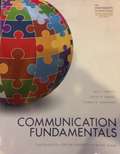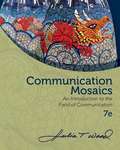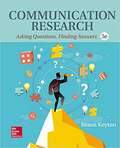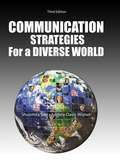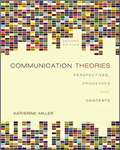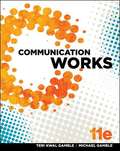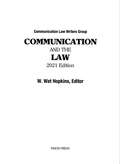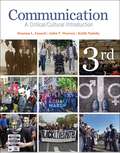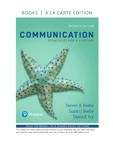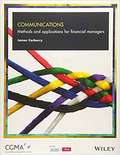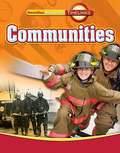- Table View
- List View
Communication Fundamentals
by Alberts Nakayama MartínCOURSE DESCRIPTION Competent communication is based on the ability to create and share meaning effectively and appropriately in a variety of contexts. This course provides students with theoretical knowledge and practical experience in communicating interpersonally, across cultures, in groups and teams, and in public spaces. We combine an understanding of the theories and research on communication with the development of practical skills. Since audience adaptation is fundamental to effective communication, an appreciation for the differences among people will be integrated into our studies. Through speeches and a paper, in-class and on-line activities, class discussions and debates, we will explore the ways in which differences shape identities and communication styles, and how to recognize and analyze the range of ways in which people communicate, in an effort to also improve our own skills in communicating with a variety of people. A primary focus in this course is on speaking effectively, using and evaluating qualitative data, and examining human differences.
Communication Mosaics: An Introduction to the Field of Communication, Seventh Edition
by Julia T. WoodCOMMUNICATION MOSAICS: AN INTRODUCTION TO THE FIELD OF COMMUNICATION, Seventh Edition, combines the author's signature first-person narrative style and popular student commentaries with thoroughly up-to-date research, theories, and technological information to provide both an overview of the field and a practical guide you can immediately use to improve your personal, professional, and public communication skills. By beginning with introductions to the basic processes and skills central to all communication contexts and then moving on to how we apply these aspects of communication in specific contexts such as interpersonal and public speaking, the text shows you the importance of developing your communication skills and gives you the hands-on tools you need to become a more effective communicator.
Communication Pathways
by Joseph M. Valenzano III Melissa Broeckelman-Post Erin ParcellFrom the authors of The Speaker and The Speaker's Primer comes an innovative new textbook that covers hybrid communication course curriculum in an approachable way. Communication Pathways introduces to the market a handbook-style approach to the hybrid course, with concise chapters that emphasize communication theory. The authors chose to organize content around a communication-centric theme: dialogue. The first section of the text dedicates an entire chapter to the subject, unpacking the concept for students; the authors further incorporate and explicate dialogic communication as it applies to subsequent chapter concepts. This theme is unique to the text and is a central element of what the authors aim to accomplish: create competent, dialogic communicators who know how to advocate ideas civilly, explain complicated subjects, and disagree without being disagreeable in a variety of interactive settings.
Communication Research: Asking Questions, Finding Answers
by Joann KeytonCommunication Research: Asking Questions, Finding Answers covers basic research issues and processes, both quantitative and qualitative, appropriate for communication students with little or no previous research methods experience. The text's guiding principle is that methodological choices are made from one's research questions or hypotheses. This avoids the pitfall in which students learn one methodology or one methodological skill and then force that method to answer all types of questions. Instead of working with one methodology to answer all types of questions, students come away understanding a variety of methods and how to apply them appropriately.
Communication Strategies In A Diverse World
by Angela Wizner Shusmita SenCommunication Strategies in a Diverse World
Communication Then and Now
by Tara Funk Katherine ScraperPeople communicate in many different ways. Read about communication long ago.
Communication Theories: Perspectives, Processes, And Contexts
by Katherine MillerProviding a current and comprehensive discussion of influential theories in communication, this text portrays the strengths and weaknesses of each theory. Communication Theories helps students see where these theories fit in the broad scheme of social inquiry and generally guides students in the evaluation and critique of theories in order to reach a more sophisticated level of understanding. Although it emphasizes theories developed by communication scholars, Communication Theories also includes work developed outside the field that has strongly influenced the work of communication scholars. The second edition has been completely updated to include new or enhanced coverage of post-colonialism, critical race theory, new generation social penetration theory, and mass media reception theory.
Communication Theory and Concepts 7th
by Martha J. HaunThe first part of this book provides an examination of the nature of theory construction, the nature of the communication process, and reviews selected theories across a variety of contexts. In part II are examples of application papers written by students. Each semester several hundred undergraduate write papers much like these. The assignment changes a bit from time to time. These were selected because they also demonstrate humor and creativity. In a matter of weeks, you too, can similarly expand your vocabulary and understanding of the communication world around you. Part III has selected power point slides for further application and concept review. Welcome to a study that can reveal dynamic new perspectives!
Communication Works
by Michael Gamble Teri Kwai GambleCommunication Works 11e applies a new critical thinking framework to its core content, now in a more user-friendly 15-chapter organization. We have retained and revised the text's practical approach to communication, with a focus on the ways in which diversity, technology, social media, and ethical concerns both enrich and complicate our world. Students will learn what role communication plays in their lives today, in the classroom, and tomorrow, in the working world.
Communication and Human Behavior
by Brent D. Ruben Lea StewartA knowledge of human behavior helps us understand ourselves, our actions, our motives, our feelings, and our aspirations… <p><p> Communication and Human Behavior portrays a broad and colorful landscape of the field, outlines the history of communication study, and focuses on communication as a basic life process that is necessary to our lives as individuals and to our relationships, groups, organizations, cultures, and societies. <p><p> Communication and Human Behavior by Brent Ruben and Lea Stewart: <p> • integrates up-to-date examples and research findings throughout, including persuasion, interpersonal relationships, organizational communication and leadership, 21st century careers, useful information about Middle Eastern culture, contemporary social media use, and more. <p> • examines the role of communication in multiple contexts of human life, including individual relationships, groups, organizations, cultural/intercultural frameworks, and public and mass communication. <p> • is expansive yet integrated, rigorous yet readable, and fuses theory and practice.
Communication in the Real World
by Richard G. Jones Jr.Communication in the Real World: An Introduction to Communication Studies by Richard G. Jones, Jr. overviews the time-tested conceptual foundations of the field, while incorporating the latest research and cutting-edge applications of these basics. Each chapter will include timely, concrete, and real-life examples of communication concepts in action. A key feature of this book is the integration of content regarding diversity and organizational communication in each chapter through examples and/or discrete sub-sections. Discussions of diversity are not relegated to feature boxes. Also integrated into the content are examples that are inclusive in terms of race, gender, sexuality, ability, age, marital status, religion, and other diverse identity characteristics.
Communication: A Critical/cultural Introduction
by Keith Nainby Deanna L. Fassett John T. WarrenThe third edition of Communication: A Critical/Cultural Introduction provides a comprehensive, yet focused, overview of communication theory, interpersonal communication, and public communication and culture through the lens of contemporary critical theory. The text shows how we produce our world through communication, challenging us to explore power, ideology, and diversity through daily interactions, both public and private. <P><P> The book begins with explanations of how communication relates to culture and power, how to distinguish between representative and constitutive communication, and how to build a message for an audience with an emphasis on social advocacy. Later chapters explore the responsibilities of speakers and listeners, alliance-building, the application of communication theory in the study of identity and perception, the relationship between language and culture, nonverbal communication, and more. The text closes with a discussion of communication as a means of social action, encouraging readers to use communication as a foundation for the advancement of issues that matter most to them.
Communication: A First Look At Communication Theory (6th Edition)
by Miriam GriffinThe most widely-used textbook for the communication theory course, "A First Look at Communication Theory" analyzes the major communication theories at a level that is appropriate for both lower- and upper- level courses. The 34 theories represented in the text reflect a mix of foundational and recent scholarship, and strike a balance of scientific and interpretive approaches
Communication: Principles For A Lifetime
by Susan Beebe Steven Beebe Diana IvyCommunication: Principles for a Lifetime was designed to address the biggest challenge when teaching Introduction to Communication: how to present the variety of fundamental theory and skills without overwhelming learners. By organizing the text around five key principles of communication, authors Steven Beebe, Susan Beebe, and Diana Ivy help students to see the interplay among communication concepts, skills, and contexts. The 7th Edition has been updated with new coverage of social media communication strategies.
Communications: Methods And Applications For Financial Managers
by James CarberryImproving communication is one of the most important – and challenging – issues that management accountants face. In a global survey of CFOs, Ernst & Young said: "Despite two thirds of respondents saying that increasingly they act as the public face of the organization, most point to communication and influencing as the most important area for improvement." <p><p> This book is specifically designed to meet the needs and interests of management accountants. It draws on interviews with finance professionals at every level of corporate accounting, as well as with communication consultants, executive recruiters and educators. It looks at how management accountants communicate inside and outside their organizations, identifies best practices, and gives hands-on strategies that accountants can use right away.
Communicative English 11th Standard - Tamilnadu Board
by Training State Council of Educational ResearchCommunicative English Textbook for the 11th Standard Students, preparing for Tamil Nadu State Board Exam.
Communicative English 12th Standard - Tamilnadu Board
by Training State Council of Educational ResearchCommunicative English Textbook for the 12th Standard Students, preparing for Tamil Nadu State Board Exam.
Communicative English class 11 (Higher Secondary First Year) - Tamil Nadu Board
by State Council of Educational Research and TrainingThe "Communicative English" textbook for Class 11 by the Tamil Nadu Board aims to develop proficiency in English through practical usage. It begins with national symbols and pledges, such as the National Anthem, Tamil Thaai Vaazhthu, and the National Integration Pledge, fostering patriotism and unity. The preface highlights the need for mastering listening, speaking, reading, and writing skills to gain confidence in using the language accurately. The book is thematic, revolving around real-life contexts to help students link their experiences with various situations, thereby enhancing communicative skills. It includes a variety of tasks designed to encourage practice in all four language skills, with grammar introduced through real-life contexts to improve fluency and accuracy. Additionally, it incorporates ICT codes and a career guidance section, providing students with opportunities to explore new learning avenues and career options in fields such as travel, tourism, logistics, and hotel management. The book aims to not only develop language skills but also instill humane values, promoting kindness, loyalty, and appreciation for nature.
Communicative English class 12 (Higher Secondary Second Year) - Tamil Nadu Board
by Tamil Nadu BoardThe "Communicative English" textbook for Class XII, published by the Government of Tamil Nadu under the Free Textbook Programme, aims to develop students' communicative competence rather than just linguistic skills. Emphasizing real-life applications, the textbook includes authentic materials such as extracts from media, magazines, and books, tailored to the learners' needs and interests. It focuses on practical communication skills, such as public speaking, interviewing, and debating, rather than traditional essay writing. The book incorporates study skills like note-taking and reference, and it encourages digital literacy through an ICT corner. It promotes values like equality and harmony, aiming for proficiency in language use in new contexts. The textbook also includes themes on human values, workplace English, road safety, art and literature, and civic sense, providing a comprehensive language learning experience aligned with the National Curriculum Framework 2005.
Communities
by Herman J. Viola Sarah Witham Bednarz Mark C. Schug Charles S. White Maryellen Vogt Cheryl Jennings Dolores Beltra Carlos E. CortésNIMAC-sourced textbook
Communities
by Dinah Zike James A. Banks Kevin P. Colleary Linda Greenow Walter C. Parker Emily M. Schell Irma M. Olmedo Raymond C. JonesMacmillian/McGraw-Hill TIMELINKS Grade 3 builds geographic mastery with maps and skills, offers reading skills and strategies to reinforce Reading/Language Arts skills, and integrates Dinah Zike's Foldables® to help students improve comprehension. * Available as a single book
Communities
by Phillip BaconThere are many ways to find out about different communities. You read about Martin and looked at pictures of his community. Reading and looking at pictures are good ways to find out about a person or a place.
